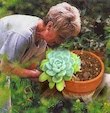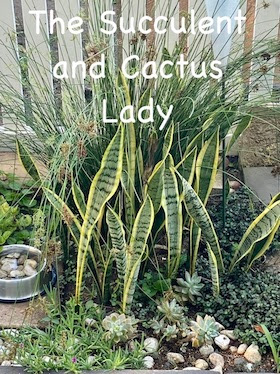About me

🌿 I've been gardening ever since a child, when I spent time with my father in his vegetable garden. But my fascination with Echeverias started in the 1980's, when my father gave me a pot with five Echeverias, which turned out to be E. imbricata. At first I wasn't much interested in them and planted them in some obscure corner of the garden and completely forgot about them. How great was my surprise when, a couple of months later, I noticed that they had spread and made a beautiful display - I was hooked!
Pages
Monday 28 December 2015
Hatiora gaertneri (Bladroos)
A native of south-eastern Brazil, Hatiora gaertneri (also known as the Easter Cactus) is a tropical cactus that requires a certain amount of regular water in order to survive. The fully grown cactus resembles a shrub. In the wild, these cacti grow on trees or rocks only, so they require a special potting mixture to keep them healthy in your home.
Immediately after flowering has finished, this cacti requires a one month resting period. During this month, restrict water to keep the soil moist only, and do not offer fertilizer. After the month, resume watering and fertilizing on a regular basis.
- Name kindly supplied by Roger - (Info from House Plants Expert)
At the beginning February 2014, a friend sent me a cutting (above) and after being "lost" in the post for almost a month, it finally arrived on the 26th February 2014, looking slightly worse for the wear. I immediate potted it up and waited. To my utter horror, it seemed to die within a couple of weeks! I left the "dead" looking plant in the pot, carefully pampering it and keeping an eye on it and it wasn’t long before, to my utter delight, new stems started to emerge (below).
By this time the cold weather was starting to settle in so, as a precaution, I brought my precious little epiphyllum indoors, to spend the winter safely in my flower room inside.
Then in September, as soon as it was warm enough, I took it back outside and within a week I was promptly rewarded with a couple of flowers.
Litrosies of bladrosies se blomme is verskillende groottes en so ook die stammetjies of takkies. Mens kry dié met die lang aaneenlopende blare wat aan die kante gekartel is, en hul dra gewoonlik die groot blomme. Sommige lyk nogal na orgideë en kom in al die kleure van ligroos, rooi tot geel en oranje voor. Sommige blommetjies het ook dubbel blaartjies en die buitenste is byvoorbeeld rooi en die middelblaartjies wit of ligroos. Die ander litroos is die kleiner tipe met die ballerina blommetjies. Die plant se blare is in litjies aanmekaar en die blommetjies is kleiner. Hierdie blommetjies het ook dubbele blaartjies met verskillende kleure aan een blommetjie. Daar is ook die gewone ou rooietjie wat enkelblommetjies dra met sy geel stuifmeeldrade. Hierdie is nogal ’n baie sterk plant. Hulle groei maklik van steggies en groei ook baie vinnig en blom ook sommer vinnig. Al behoort hulle aan die kaktusse, hou hulle nogal in die warm somer van genoeg water. Hulle is wel gevoelig vir baie koue en ryp. Hul kan in volson of semi-skadu geplant word en sal oral baie goed blom.
::
Thursday 24 December 2015
The happiest season of all!
Christmas, and summer time. Everything is in full flower. Surely it must be the happiest season of all! Here's wishing you a Merry Christmas and a festive season filled with LOVE, JOY and INSPIRATION!
Saturday 19 December 2015
The joy of succulents in pots
Although succulents and cacti and are renowned for their 'easy care' and drought and heat tolerance, many succulents you may have in your garden might not be suited to your specific climate - some may prefer little water, some may thrive on lots more water, some may even prefer the shade and many might not be tolerant of too much cold or heavy frost.
Echeveria imbricata - doesn't tolerate frost and thrives on lots of water
That is the situation I have with many of my succulents. Here where I live (in Tarlton, Gauteng, South Africa), we can have winters with extremely heavy frost. Even though we rarely experience temperatures below -2℃, which most succulents do not have a problem with, I have lost many an Echeveria because of the frost at temperatures well above freezing.
Another problem is the beautiful, rich, deep topsoil l have in my garden. That brings it's own set or problems - the soil is extremely porous and well-drained and even heavy rain tends to sink right down to well below where the plants can get hold of it (most succulents and cacti have very shallow root systems).
The joy of having your succulents in pots is the fact that you can control temperature by moving them either into the sun or into shade, you can tend to each one's water requirements separately and, if your pot is well-drained, even over-watering is hardly ever a problem. It's wise to pot your most precious and rarer succulents, ensuring that you may enjoy their beautfy for many years to come.
Shade- and water-loving Crussula imperialis
Echeveria imbricata in Terracotta pots that are easy to move under cover for winter
A young Aloe ferox starting its life in the safety of a pot, avoiding frost in the early years
Euphorbia cooperi (Transvaal candelabra) which I raised from a baby but lost one winter because I forgot to being it inside. It is mostly found in wooded grassland and rocky places from KwaZulu-Natal, through Swaziland and up to Messina in Limpopo, all basically frost-free areas.
Keeping my Austrocylindropuntia subulata (Eve's Needle) in a pot, reduces the chances of this weed-like opuntia spreading all over the garden
This Cactus trichocereus echinopsis hybrid is in a pot just because he's so beautiful and I love to look at him!
Echeveria imbricata thriving in dappled shade on my patio with protection from the frost from some overhanging branches
An Haworthia, some Aloe aristata (Guinea-fowl Aloe or Lace Aloe) and Peanut Cactus in an enamel bowl on my patio table. I often use some of my potted succulents as centre pieces for breakfast or lunch parties.
::
Subscribe to:
Posts (Atom)
















